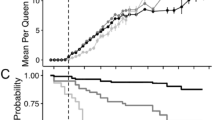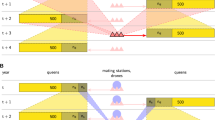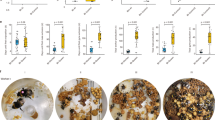Abstract
INSECT societies have long served as useful models in the study of two often intertwined issues in evolutionary biology: the levels at which natural selection operates1, and the phenomena of competition and cooperation in animal societies2. Hamilton3–5 provided a darwinian explanation for the evolution of cooperation by invoking natural selection for increased inclusive fitness, whereas Trivers and Hare6 showed how asymmetrical genetic relationships among members of hymenopteran societies result in differential fitness among queens and workers and can lead to conflict over the production of males. Here we provide evidence for competition among workers of the honey bee, Apis mellifera, in the production of female reproductives, a consequence of the genetic structure of colonies resulting from polyandry7, genotypic biases in components of cooperative behaviour associated with division of labour8–10, and kin recognition11–13. We also propose that nepotistic behaviour by honey bees is influenced by both kin- and colony-level selection.
This is a preview of subscription content, access via your institution
Access options
Subscribe to this journal
Receive 51 print issues and online access
$199.00 per year
only $3.90 per issue
Buy this article
- Purchase on Springer Link
- Instant access to full article PDF
Prices may be subject to local taxes which are calculated during checkout
Similar content being viewed by others
References
Darwin, C. The Origin of Species 250–257 (Mentor, New York, 1958).
Wheeler, W. H. Social Life Among the Insects 3–6 (Harcourt Brace, New York, 1923).
Hamilton, W. D. J. theor. Biol. 7, 1–16 (1964).
Hamilton, W. D. J. theor. Biol. 7, 17–52 (1964).
Hamilton, W. D. A. Rev. ecol. Syst. 3, 193–232 (1972).
Trivers, R. L. & Hare, H. Science 191, 249–263 (1976).
Page, R. E. A. Rev. Entomol. 31, 297–320 (1986).
Calderone, N. W. & Page, R. E. Behav. Ecol. Sociobiol. 22, 17–25 (1988).
Robinson, G. E. & Page, R. E. Nature 333, 356–358 (1988).
Frumhoff, P. C. & Baker, J. Nature 333, 358–361 (1988).
Getz, W. M. & Smith, K. B. Nature 302, 147–148 (1983).
Frumhoff, P. C. & Schneider, S. Anim. Behav. 35, 255–262 (1986).
Evers, C. A. & Seeley, T. D. Anim. Behav. 34, 924–925 (1986).
Page, R. E. & Laidlaw, H. H. Anim. Behav. 36, 944–945 (1988).
Pamilo, P. & Crozier, R. H. Theor. Pop. Biol. 21, 171–193 (1982).
Sokal, R. R. & Rohlf, F. J. Biometry 691–778 (Freeman, San Francisco, 1981).
Page, R. E. & Erickson, E. H. Ann. ent. Soc. Am. 77, 578–580 (1984).
Visscher, P. K. Behav. Ecol. Sociobiol. 18, 453–460 (1986).
Noonan, K. C. Ethology 73, 295–306 (1986).
Queller, D. C., Strassmann, J. E. & Hughes, C. R. Science 242, 1155–1157 (1988).
Crow, J. F. Scient. Am. 240, 104–113 (1979).
Sober, E. in PSA 1980 (eds Asquith, P. D. & Giere, R.) 93–121 (Philosophy of Science Association, East Lansing, 1981).
Laidlaw, H. H. Instrumental Insemination of Honey Bee Queens (Dadant, Hamilton, 1977).
Contel, E. P. B., Mestriner, M. A. & Martins, E. Biochem. Genet. 15, 859–876 (1977).
Moritz, R. F. A. J. Apic. Res. 24, 249–255 (1983).
Laidlaw, H. H. & Page, R. E. Genetics 108, 985–997 (1984).
Winston, M. L. The Biology of the Honey Bee 181–213 (Harvard Univ. Press, Cambridge, 1987).
Laidlaw, H. H., Contemporary Queen Rearing (Dadant, Hamilton, 1979).
Author information
Authors and Affiliations
Rights and permissions
About this article
Cite this article
Page, R., Robinson, G. & Fondrk, M. Genetic specialists, kin recognition and nepotism in honey-bee colonies. Nature 338, 576–579 (1989). https://doi.org/10.1038/338576a0
Received:
Accepted:
Issue Date:
DOI: https://doi.org/10.1038/338576a0
This article is cited by
-
Plasticity for the kin and conspecific preferences in the frog tadpoles (Rana ornativentris)
Animal Cognition (2022)
-
Decoupled evolution of mating biology and social structure in Acromyrmex leaf-cutting ants
Behavioral Ecology and Sociobiology (2022)
-
In-hive variation of the gut microbial composition of honey bee larvae and pupae from the same oviposition time
BMC Microbiology (2019)
-
Do Bumble Bees Produce Brood Pheromones?
Journal of Chemical Ecology (2019)
-
Rapid parallel evolution overcomes global honey bee parasite
Scientific Reports (2018)
Comments
By submitting a comment you agree to abide by our Terms and Community Guidelines. If you find something abusive or that does not comply with our terms or guidelines please flag it as inappropriate.



